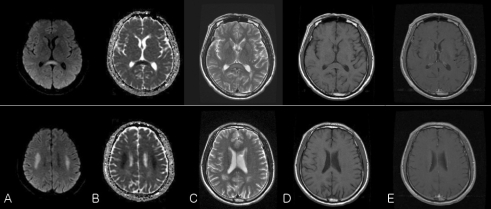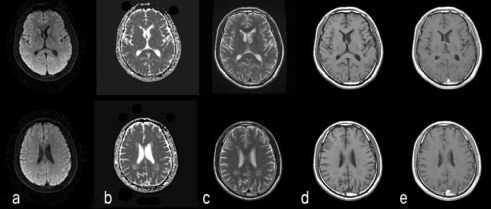Abstract
A 59-year-old man visited an emergency room due to the sudden onset of severe dysarthria with a drowsy mental status. MRI demonstrated T2 prolongation and restricted diffusion involving the splenium of the corpus callosum and bilateral frontal white matter neurological signs and symptoms were mild, and the recovery was complete within a week. Follow-up MRI performed one month later revealed complete resolution of the lesions. The clinical and radiological courses were consistent with previously reported reversible isolated splenial lesions in mild encephalitis/encephalopathy except for the presence of frontal lesions. This case suggests that such reversible lesions can occur outside the splenium.
Keywords: Reversible Lesion, Splenium, Corpus Callosum, Encephalitis/Encephalopathy
Reversible MRI lesions with transiently restricted diffusion in the splenium of the corpus callosum (SCC) without any accompanying lesions have been reported in patients receiving antiepileptic drugs and experiencing trauma and high-altitude disease.1-5 This unusual MRI finding also has been reported in patients with clinically mild encephalitis/encephalopathy.1-4,6,7 Some authors have thus called this condition mild encephalitis/encephalopathy with a reversible isolated SCC lesion (MERS).2
We recently experienced a 59-year-old man with clinically mild encephalopathy, in whom brain MRI showed reversible lesions with transiently restricted diffusion in the SCC and bilateral frontal white matter. The clinical and radiological courses were identical to those of the reversible isolated SCC lesions previously reported in MERS.
CASE REPORT
A 59-year-old man visited an emergency room due to the sudden onset of severe dysarthria with a drowsy mental status. A neurologic examination revealed no other focal neurological deficits. Despite his drowsy mental state, he could fully understand questions, but answered them using letters. He had been receiving hypertensive medication for 7 years and antiplatelet medication for 3 years. He stated that he was not using any other drugs or alcohol, nor had toxin exposure or experience of weight loss. Three days before the admission, he had a mild headache, general myalgia, and chilling sensation, but had taken no medication. At admission, his body temperature was 37.7℃; except for the slight elevated body temperature, his vital signs (blood pressure, respiration rate, and pulse rate) were within the normal ranges. On the admission day, brain diffusion-weighted imaging (DWI) showed high-intensity signals in the SCC and symmetric bilateral frontal white matter. A low apparent diffusion coefficient (ADC) was noted in the same areas. On the next day, T2-weighted MRI showed high-intensity signals, whereas T1-weighted MRI showed no signal changes in the same regions. Brain contrast-enhanced MRI revealed no enhanced lesions (Fig. 1). There were no inflammation signs or abnormalities in complete blood count, blood chemistry, urine analysis, cerebrospinal fluid, and a chest X-ray. No specific therapy was applied, and 2 days later he showed alert mentality and improved dysarthria. Another 3 days later he had only slight dysarthria, and his clinical symptoms were completely resolved within 7 days. Follow-up brain MRI was performed 1 month later. No abnormal signal changes were noted in diffusion-weighted, ADC, T1-weighted, or T2-weighted MRI. Brain contrast-enhanced MRI showed no enhanced lesions (Fig. 2), and lesions in the SCC associated with symmetric bilateral frontal white-matter changes were completely resolved.
Figure 1.
On admission day, brain DWI (a) showed high-intensity signals in the splenium of the corpus callosum associated with symmetric bilateral frontal white-matter changes. (b) The same regions exhibited low ADC signals. (c) On the next day, brain T2-weighted MRI showed high-intensity signals in the same area. (d) Brain T1-weighted MRI demonstrated no high-intensity-signal changes. (e) Brain contrast-enhanced MRI showed no enhanced lesion.
Figure 2.
One month later, follow-up brain diffusion- weighted (a), ADC (b), T2-weighted (c), and T1-weighted (d) MRI images showed no abnormal signal changes. (e) Brain contrast-enhanced MRI showed no enhanced lesion. The lesions in the SCC associated with symmetric bilateral frontal white-matter changes were completely resolved.
DISCUSSION
The SCC exhibits irregular water component and low homogeneity. Myelin sheaths in the SCC exhibit a relatively high water component, and the SCC is more susceptible to cytotoxic edema than other brain areas.4,6
Encephalitis is defined as an acute onset of brain dysfunction associated with inflammatory changes of the CSF. When there is no evidence of inflammatory changes, as in the case of our patient, the condition can be diagnosed as encephalopathy.
In any encephalitis/encephalopathy patient with lesions in the white matter, Acute disseminated encephalomyelitis (ADEM) should be considered in the differential diagnosis.1-3,6 However, in ADEM, recovery occurs within weeks, and in our case the symptoms recovered within 7 days without specific treatment. MRI in ADEM usually shows multiple foci of T1 and T2 prolongation in the subcortical white matter that typically is bilateral and asymmetric. The lesions usually evolve over weeks to months and disappear only after several months. After contrast-agent infusion, ADEM lesions will show variable enhancement depending on their acuity. No enhanced MRI lesions were detected in the present case.
Reversible MRI lesions in the SCC have been reported in patients with epilepsy receiving antiepileptic drugs1,8 and in patients with MERS.1,6 However, our patient was not receiving antiepileptic drugs.
All reported patients with MERS have had mild clinical courses, recovering completely without any sequelae. The previous reports of MERS excluded those patients with parenchymal lesions in addition to the reversible SCC lesion.1,3,6 More recently, symmetric reversible lesions with transiently restricted diffusion were seen in the peripheral frontoparietal white matter and SCC of some patients with encephalitis/encephalopathy.1,2 The clinical signs and symptoms of these patients were mild, and their recovery complete. The signal characteristics, reversibility of the lesions, and the clinical features of the patients were identical to those seen in MERS.2 We consider our patient to be similar to those described as MERS.
Reversible brain lesions have been attributed to the transient development of intramyelinic edema due to the separation of myelin layers, which is a possible mechanism for the transiently decreased diffusion of the SCC lesion.2,3,6 However, a reversible SCC lesion with reduced diffusion has been observed in a 12-day-old neonate.9 At that age the SCC is still completely unmyelinated, and hence mechanisms other than intramyelinic edema must be responsible for at least some of the cases of reversible SCC lesion. Another possible explanation is the development of an inflammatory infiltrate. The influx of inflammatory cells and molecules, possibly combined with related cytotoxic edema, might have decreased the ADC. However, the symmetry and absence of contrast enhancement in our patient makes an inflammatory etiology less likely, since inflammation is rarely completely symmetric and often causes transient impairment of the blood-brain barrier. Thus the reason for the callosal involvement in these cases remains purely speculative.
The clinical and radiological courses of our patient were identical to those of previously reported reversible lesions isolated to the SCC in MERS. This suggests that such reversible lesions are not necessarily restricted to the SCC. Only a few Korean cases of reversible SCC lesions in encephalitis/encephalopathy have been reported, 4,6 and here we have presented the first case of reversible SCC lesions with bilateral white-matter changes in encephalitis/encephalopathy in Korea.
References
- 1.Takanashi J, Barkovich AJ, Shiihara T, Tada H, Kawatani M, Tsukafara H, et al. Widening spectrum of a reversible splenial lesion with transiently reduced diffusion. AJNR Am J Neuroradiol. 2006;27:836–838. [PMC free article] [PubMed] [Google Scholar]
- 2.Takanashi J, Hirasawa K, Tada H. Reversible restricted diffusion of entire corpus callosum. J Neurol Sci. 2006;247:101–104. doi: 10.1016/j.jns.2006.03.015. [DOI] [PubMed] [Google Scholar]
- 3.Tada H, Takanashi AJ, Barkovich H, Oba H, Maeda M, Tsukahara H, et al. Clinically mild encephalitis/encephalopathy with a reversible splenial lesion. Neurology. 2004;63:1854–1858. doi: 10.1212/01.wnl.0000144274.12174.cb. [DOI] [PubMed] [Google Scholar]
- 4.Seo HJ, Kim SY, Kim WM, Hong YJ, Sohn JH, Lee SM, et al. A case of encephalitis with a reversible splenial lesion on a diffusion weighted MRI image. J Korean Neurol Assoc. 2006;24:507–510. [Google Scholar]
- 5.Uchino A, Takasa Y, Nomiyama K, Egashira R, Kudo S. Acquired lesions of the corpus callosum: MR imaging. Eur Radiol. 2006;16:905–914. doi: 10.1007/s00330-005-0037-9. [DOI] [PubMed] [Google Scholar]
- 6.Hong JM, Park MS, Jun DC. Transient splenial lesion of the corpus callosum in patients with infectious disease. J Korean Neurol Assoc. 2005;23:667–669. [Google Scholar]
- 7.Kobata R, Tsukahara H, Nakai A, Tanizawa A, Ishimori Y, Kawamura Y, et al. Transient MR signal changes in the splenium of the corpus callosum in rotavirus encephalopathy: value of diffusion-weighted imaging. J Comput Assist Tomogr. 2002;26:825–828. doi: 10.1097/00004728-200209000-00028. [DOI] [PubMed] [Google Scholar]
- 8.Shin YE, Cho YW, Kim HA, Sohn SI, Lee HL, Lim JG, et al. Two cases of transient focal lesion in the splenium of the corpus callosum after aggravated seizures. J Korean Neurol Assoc. 2005;23:111–1139. [Google Scholar]
- 9.Takanashi J, Maeda M, Hayashi M. Neonate showing a reversible splenial lesion. Arch Neurol. 2005;62:1481–1482. doi: 10.1001/archneur.62.9.1481. [DOI] [PubMed] [Google Scholar]




